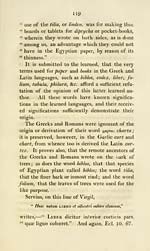Download files
Complete book:
Individual page:
Thumbnail gallery: Grid view | List view

115
ed from the grosser outer bark, and prepared in
such a manner as to be rendered fit for receiving
and retaining written characters.
" Paper bark," says Mr Chahners, " if it may
' be so called, was only the liber or inner whit-
' ish rind enclosed between the outer bark and
' the wood of diverse trees, as the maple, plain,
' beech and elm; but especially the ^z/^'tf, (pi>^v^x, or
' linden tree, which was that mostly used for
' this purpose. On this, stripped off, flatted and
' dried, the ancients wrote books, several of
* which are said to be still extant. Mabillon
' and Monfaucon speak frequently of manu-
' scripts and diplomas on bark, and are very
' express between \\\t papyrus used by the Egyp-
' tians, and the liber or bai^k in use in other
' countries. The two are alleged to differ in this,
' tliat the bark paper was thicker and more
' brittle than the papymis, as well as more apt
' to cleave or shiver, by which the writing was
' sometimes lost, as is the case in a bark manu-
' script in the Abbey of St Germains, where the
' bottom of the paper remains, but the outer sur-
' face, on which the letters had been drawn, is in
' many places peeled off. But Maffei, it must
' not be forgot, combats the whole system of
' bark manuscripts and charters as a popular
' error, and maintains, that the ancients never
' wrote diplomas on bark; that the distinction
' between the papers made of papyrus and of
' CGi^tex is without foundation : that the only
ed from the grosser outer bark, and prepared in
such a manner as to be rendered fit for receiving
and retaining written characters.
" Paper bark," says Mr Chahners, " if it may
' be so called, was only the liber or inner whit-
' ish rind enclosed between the outer bark and
' the wood of diverse trees, as the maple, plain,
' beech and elm; but especially the ^z/^'tf, (pi>^v^x, or
' linden tree, which was that mostly used for
' this purpose. On this, stripped off, flatted and
' dried, the ancients wrote books, several of
* which are said to be still extant. Mabillon
' and Monfaucon speak frequently of manu-
' scripts and diplomas on bark, and are very
' express between \\\t papyrus used by the Egyp-
' tians, and the liber or bai^k in use in other
' countries. The two are alleged to differ in this,
' tliat the bark paper was thicker and more
' brittle than the papymis, as well as more apt
' to cleave or shiver, by which the writing was
' sometimes lost, as is the case in a bark manu-
' script in the Abbey of St Germains, where the
' bottom of the paper remains, but the outer sur-
' face, on which the letters had been drawn, is in
' many places peeled off. But Maffei, it must
' not be forgot, combats the whole system of
' bark manuscripts and charters as a popular
' error, and maintains, that the ancients never
' wrote diplomas on bark; that the distinction
' between the papers made of papyrus and of
' CGi^tex is without foundation : that the only
Set display mode to: Large image | Transcription
Images and transcriptions on this page, including medium image downloads, may be used under the Creative Commons Attribution 4.0 International Licence unless otherwise stated. ![]()
| Early Gaelic Book Collections > Ossian Collection > Thoughts on the origin and descent of the Gael > (130) |
|---|
| Permanent URL | https://digital.nls.uk/82236004 |
|---|
| Description | Selected books from the Ossian Collection of 327 volumes, originally assembled by J. Norman Methven of Perth. Different editions and translations of James MacPherson's epic poem 'Ossian', some with a map of the 'Kingdom of Connor'. Also secondary material relating to Ossianic poetry and the Ossian controversy. |
|---|
| Description | Selected items from five 'Special and Named Printed Collections'. Includes books in Gaelic and other Celtic languages, works about the Gaels, their languages, literature, culture and history. |
|---|

